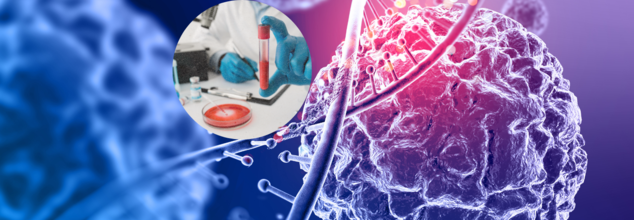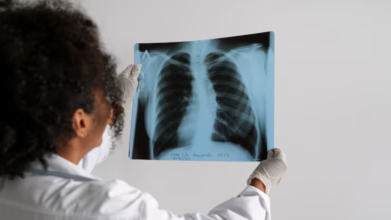- Health Conditions A-Z
- Health & Wellness
- Nutrition
- Fitness
- Health News
- Ayurveda
- Videos
- Medicine A-Z
- Parenting
- Web Stories
Scientists Detect Early Signs of Cancer In Patient Blood Years Before Diagnosis; Will It Prevent Early-Onset Cancers?

Credits: Canva
The vision of a world where cancer could be detected and treated before it ever causes symptoms—where a simple blood test could reveal the earliest whispers of disease, years before a diagnosis would otherwise be made. It is rapidly moving closer to reality, thanks to pioneering research from U.S. scientists who have demonstrated that blood biomarkers can reveal the presence of cancer more than three years before traditional diagnosis.
Spotting cancer early is one of the most powerful ways to improve survival rates. Tumors caught in their infancy are far more likely to be curable, and treatments can be less aggressive, with fewer side effects. The latest findings, published in Cancer Discovery, suggest that we are on the brink of a new era in cancer screening—one powered by advanced blood tests that can catch cancer in its earliest, most treatable stages.
How Can Blood Reveal the Unseen Caner?
The key to this study lies in circulating tumor DNA, or ctDNA—tiny fragments of genetic material that break off from cancerous cells and float through the bloodstream. Though rare and extremely difficult to detect at low concentrations, these fragments can carry tumor-specific mutations that act as red flags for early cancer development.
Led by oncology researcher Yuxuan Wang and a team at Johns Hopkins University, the study analyzed blood samples from 26 individuals who were later diagnosed with cancer within six months. These were compared with blood samples from 26 cancer-free individuals from the same health study cohort.
Using a combination of sophisticated algorithms and a multi-layered validation system, researchers were able to identify ctDNA signatures associated with cancer in eight of the 26 patients—nearly 31% of those who eventually received a diagnosis. Remarkably, blood samples taken more than three years earlier were available for six of those eight individuals, and in four of those cases, tumor DNA was already present—albeit at levels up to 80 times lower than those detected closer to diagnosis.
Why Is 3 Year A 'Big' Window?
What makes this research truly remarkable is the ability to detect cancer up to three years before clinical diagnosis. For six of the eight positive cases, the researchers had access to even older blood samples—taken 3.1 to 3.5 years before the cancer was diagnosed. In four of these six cases, the same tumor DNA fragments were already present, albeit at levels up to 80 times lower than those detected by the MCED test closer to diagnosis.
This three-year window could be transformative. “Three years earlier provides time for intervention,” explains Wang. “The tumors are likely to be much less advanced and more likely to be curable.” Early detection means more options for patients, less invasive treatments, and a better chance at long-term survival.
Despite these promising findings, there are limitations that need to be addressed before such testing becomes mainstream. The lower the ctDNA levels, the harder they are to detect reliably. Achieving the necessary sensitivity for detecting such minuscule concentrations remains a significant hurdle.
“This study shows the promise of MCED (multi-cancer early detection) tests in detecting cancers very early, and sets the benchmark sensitivities required for their success,” said Dr. Bert Vogelstein, an oncology researcher at the Ludwig Center at Johns Hopkins.
How The Test Impact Future Cancer Treatments?
This research is part of a global movement toward liquid biopsies—blood tests that can detect cancer, monitor its progression, and even guide treatment decisions. Scientists around the world are racing to develop tests that can spot multiple types of cancer from a single blood sample, with some already in clinical trials.
The potential impact is enormous. Early detection could dramatically increase survival rates for many cancers, including those that are often caught late, such as pancreatic, ovarian, and lung cancers. It could also reduce the need for invasive diagnostic procedures and make screening more accessible to people everywhere.
If refined and rolled out at scale, blood-based MCED tests could revolutionize cancer screening programs. Current methods, such as mammograms, colonoscopies, and pap smears, are specific to certain types of cancer and often detect issues only after symptoms emerge. A single blood test capable of catching multiple cancers before they manifest could dramatically improve early intervention strategies.
Can Early Detection Prevent Early-Onset Cancers?
Current evidence indicates that early detection and screening can significantly improve cancer survival rates and reduce the need for aggressive treatments, especially for cancers like breast and colorectal cancer when caught early. However, early detection does not prevent the initial development of early-onset cancers—it enables clinicians to identify cancers or pre-cancerous changes at a stage when treatment is more likely to be successful and less invasive.
Researchers say that detecting these cancers before they reach advanced stages could open new doors for targeted prevention strategies, especially for people with a family history of cancer or genetic predispositions. “If early-onset cancers can be caught even before the first symptoms appear, we not only improve survival but also preserve quality of life,” said Dr. Wang.
However, experts caution that while early detection is a critical first step, it must be paired with timely follow-up and interventions tailored to the unique biology of early-onset cancers. Continued research into how these cancers evolve at the genetic and epigenetic levels will be key to refining detection methods and crafting personalized treatment paths.
Prevention strategies—such as lifestyle changes, vaccination, and minimizing risk factors—are essential for reducing the risk of developing cancer in the first place. Early detection, through methods like screening and advanced blood tests, is focused on finding cancer at its most treatable stage, not on preventing its onset. For rapidly growing or aggressive cancers, early detection may still face limitations, as some tumors can develop and spread between screening intervals.
Early detection technologies are powerful tools for improving outcomes and survival but do not prevent early-onset cancers from occurring.
PCOS Awareness Month: 5 Lifestyle Tips To Manage PCOS According To Gynecologist

Credits: Canva
September is the month for PCOS awareness, which stands for Polycystic Ovary Syndrome. This is a condition that impacts a woman's hormonal levels, disturbs their menstrual cycle and can make everyday life challenging. As per the World Health Organization (WHO), PCOS affects an estimated of 6-13% of reproductive-aged women. Up to 70% of affected women remain undiagnosed worldwide. The condition is also associated with variety of long-term health problems that affect physical and emotional well-being.
1 in 5 Young Indian Women Has PCOS
As per a 2019 study published in the Indian Journal of Medical Research, 1 in 5 young Indian women suffer form PCOS. In some areas, suggests the study, the prevalence is as high as 29% to 35% women with PCOS, which has also contributed to widespread infertility issues. These percentages are far higher than the global prevalence that is noted by the WHO for PCOS, which is an average of 6-13%.
However, the symptoms could be managed through lifestyle changes.
5 Tips To Manage PCOS, According To Gynecologist
Dr Madhulika Singh, Senior Consultant Obstetrician & Gynaecologist at Ankura Hospital for Women and Child, Pune, as reported by Moneycontrol suggests these 5 tips, which can help one manage PCOS:
Diet Choices
Maintaining a healthy diet is a vital part of managing PCOS. Processed foods, refined sugar, and oily snacks often make symptoms worse. A more balanced approach focuses on whole grains, fresh vegetables, fruits, and healthy fats. Food, in this sense, works not just as fuel but also as medicine. For a tailored plan, consulting a nutritionist can be very useful.
Get Your Body Moving
Regular physical activity helps reduce insulin resistance, supports weight management, and improves overall mood. This doesn’t mean hours of intense exercise—activities like brisk walking, yoga, or light strength training for at least 30 minutes a day can be highly effective. Stress management also plays a big role, since chronic stress disrupts hormones. Simple routines such as meditation, deep breathing, or gentle stretching can restore balance and help control flare-ups.
Prioritize Your Sleep
Sleep is more than rest—it’s the body’s way of repairing itself. Poor sleep disrupts hormones and increases cortisol levels, which can worsen PCOS symptoms. Consistently aiming for 7 to 8 hours of quality, uninterrupted sleep can make a significant difference in overall health.
Sip, Soothe, and Support
Certain herbal teas, including spearmint, cinnamon, and flaxseed infusions, may help ease inflammation and support hormonal health. While these natural remedies can provide gentle support, they should complement—not replace—professional medical guidance.
Managing PCOS
PCOS is not a life sentence. With early action, consistent habits, and the right support, it can be managed effectively. The key lies in listening to the body, maintaining a balanced lifestyle, and seeking medical advice whenever something feels off.
Common Symptoms Of PCOS:
- Irregular period
- Weight gain around the sides and tummy
- Facial hair
- Stubborn acne
PCOS can also lead to type 2 diabetes, hypertension, heart issues and anxiety and depression, if not managed.
World Lung Day: Why Lung Cancer Remains The Top Risk For Death In Women, Even Those Who Do Not Smoke

(Credit-Freepik)
Lung cancer, as the World Health Organization (WHO) reports, is the leading cause of cancer-related deaths in most men and women, causing the death of an estimated 635,547 people in the US in 2022. However, a surprising statistic arose when the number of deaths caused by lung cancer in men dropped however, in women it has increased. The reason, suggest some researchers, could be because of a unique immune system in women that makes them more vulnerable to lung cancer. Find more information below:
For a long time, breast cancer has been a well-known health concern for women. However, over the past two decades, lung cancer rates in women have risen. According to the Lung Cancer Research Foundation, over 600,000 women die of lung cancer each year and one in 17 women will develop lung cancer in their lifetime.
Also Read: 3 Tests You Should Get Before 30s To Protect Your Heart, According To Cardiologist
This shift highlights a changing dynamic in who is affected by this disease, and it's a trend that's especially noticeable as smoking rates decline.
A surprising factor that has also been noted is that 20% of lung cancer diagnoses occur in non-smokers. What has caused these statistics and why are non-smokers at risk?
Why Lung Cancer Is on the Rise in Women
According to the Brown Health University, several factors may explain why women are increasingly affected by lung cancer:
Increased Vulnerability
Studies suggest that female smokers may be more likely to develop lung cancer than male smokers, even with similar levels of cigarette exposure.
Higher Rates in Non-Smokers
A larger proportion of women diagnosed with lung cancer are people who have never smoked.
Slower Decline in Smoking
The drop in smoking rates has been more significant among men than women, which has led to a more dramatic decrease in male lung cancer cases.
These combined factors suggest that as society moves away from tobacco, the risk of lung cancer seems to be disproportionately affecting women.
Why are Non-Smokers At Risk for Lung Cancer?
Brown Health University also states that while smoking is the leading cause of lung cancer, about 15% of all cases are diagnosed in people who have never smoked. For women with lung cancer, this number is even higher at 24%.
The exact reasons for lung cancer in non-smokers aren't fully understood, but it's likely due to a combination of environmental and biological factors. The lungs are constantly exposed to our surroundings, and things like secondhand smoke, radon gas, air pollution, and even certain viruses can increase a person's risk.
Some researchers also speculate that a woman’s unique immune system, designed to tolerate a fetus during pregnancy, might make her more vulnerable to early lung cancers that an immune system might otherwise clear.
What Is The Best Way To Combat High Lung Cancer Numbers?
The best tool for lung cancer screening is a CT scan. However, it's not recommended for people with a very low risk of the disease, such as those who have never smoked. The potential for harm, like finding benign growths that lead to unnecessary tests and procedures, outweighs the benefits in these cases.
Lung cancer screening is typically recommended for active smokers or heavy former smokers between the ages of 55 and 80. If you fit this criteria, you should speak with your doctor to see if you qualify.
What Are The First Symptoms Of Lung Cancer?
Unfortunately, the early symptoms of lung cancer are often confused with common respiratory infection like a common cold. These can include a
Persistent new cough
Shortness of breath
Wheezing
Hoarseness
While it's hard to ask healthy people to be on the lookout for such common symptoms, it's important to seek medical attention if these symptoms are unusually severe, long-lasting, or unexplained.
Lung Cancer Risk For People Who Never Smoked
Brown Health states that there is good news for non-smokers diagnosed with lung cancer. Their tumors often have specific genetic mutations (like EGFR, ALK, or ROS1) that can be treated with highly effective targeted drugs, which are often more successful than traditional chemotherapy or immunotherapy. Doctors now routinely test all patients with advanced lung cancer for these mutations.
As society becomes smoke-free, the overall death rate from lung cancer will continue to fall. However, thousands of Americans will still develop the disease from past exposure or for reasons unrelated to smoking. We must continue to push for better treatments and increased compassion for all lung cancer patients, regardless of their smoking history.
Tylenol And Autism: Acetaminophen Use During Pregnancy Does Not Cause Autism, According To Yale Doctor

Credits: AP, Yale University
For decades, acetaminophen, commonly known as paracetamol and branded Tylenol in the US has been considered the safest over-the-counter pain reliever for pregnant women. From headaches to fever relief, it has been the go-to medication recommended by doctors worldwide. However, thanks to the recent press conference in White House, President Donald Trump has now linked its use during pregnancy with autism and autism spectrum disorder (ASD).
In 2025, U.S. Health and Human Services Secretary Robert F. Kennedy Jr. highlighted this concern, announcing a $50 million Autism Data Science Initiative in May and issuing a warning in September about the potential link between acetaminophen and autism.
Also Read: World Lung Day: Why Lung Cancer Remains The Top Risk For Death In Women, Even Those Who Do Not Smoke
Despite such concerns, researchers stress that there is still no proven causal relationship between acetaminophen and autism.
What the Research Shows So Far
Dr. Zeyan Liew, Associate Professor at the Yale School of Public Health, has spent years investigating the environmental and medical contributors to neurodevelopmental disorders. His team’s work examines not only medication safety but also maternal health factors that may affect child development.
“We do not know yet for sure whether acetaminophen causes autism,” Dr. Liew explained. “Multiple observational studies across different populations have shown associations between frequent and long-term use in pregnancy and some negative effects on a child’s neurodevelopment. However, not all studies are specific about autism.”
These studies are important, but they also have limitations. Observational studies can show correlations, but they cannot confirm direct causation. Other health conditions may explain the link. For instance, fever during pregnancy is itself known to increase the risk of neurodevelopmental delays. Genetics, maternal illnesses, or concurrent use of other medications could also play a role.
In other words, while researchers have observed patterns, they cannot yet conclude that acetaminophen use during pregnancy is the cause of autism.
Yale’s Current Investigations
Dr. Liew is currently leading two major projects to shed more light on the issue.
One is an international collaborative study that looks at acetaminophen use in pregnancy and its relationship to six domains of neurodevelopment, from early to late childhood. “The project will also evaluate related factors, including maternal medical conditions, other treatments taken with acetaminophen, and family history of mental or physical health problems,” Liew said.
Also Read: All About The AMT-130 Gene Therapy - Treatment For Huntington's Disease
The second project, based at Yale, focuses on maternal behaviors and decision-making when it comes to using over-the-counter medications. Researchers are studying perceived risks, barriers to clinical consultation, and how safety information shapes women’s choices during pregnancy.
These studies aim to provide a clearer picture of how acetaminophen is used, the contexts in which it is taken, and whether its risks differ depending on frequency, dosage, or co-existing health conditions.
Are There Safe Alternatives?
When it comes to pain relief during pregnancy, acetaminophen has long been seen as the only widely recommended option. Alternatives such as ibuprofen or aspirin are generally discouraged, especially after 20 weeks of pregnancy, because of potential risks to fetal health.
“Unfortunately, there is no equivalent alternative for acetaminophen at the moment,” Dr. Liew noted. That means medical guidelines will continue to emphasize its use, at least until stronger evidence suggests otherwise.
For now, health authorities including the U.S. Food and Drug Administration (FDA) and the Centers for Disease Control and Prevention (CDC) continue to recommend acetaminophen as the safest over-the-counter pain reliever for pregnant women, provided it is used in the lowest effective dose for the shortest necessary duration.
Balancing Benefits and Risks
One of the biggest challenges is communicating medication safety without creating unnecessary alarm.
“These are nuances in medication safety communication,” Dr. Liew said. “We do not want people to fear using a treatment, but we also need to be mindful about limiting potential harm and risks.”
Pregnant women may worry about prolonged or frequent acetaminophen use. However, untreated fever or significant pain can also be harmful to both mother and child. Conditions such as high fever have well-documented risks for pregnancy outcomes and fetal development.
The balance, therefore, lies in careful, guided use: only when necessary, at the lowest dose, and in consultation with a healthcare provider.
Autism: A Complex Puzzle
Even as researchers probe possible links with medications, it’s important to remember that autism is not caused by a single factor.
“Autism is a highly complex disorder,” Dr. Liew explained. “As of now, researchers have not been able to pinpoint a single causal genetic or environmental factor. Hence, it is premature to declare we know for sure what is causing autism.”
Experts emphasize that continuing research into both genetic influences and environmental exposures remains crucial. The reality is that autism likely arises from a combination of multiple factors, some inherited, some related to prenatal conditions, and possibly others not yet understood.
For now, acetaminophen remains the standard and safest option for pain relief during pregnancy, but with an important caveat: moderation and medical guidance are key.
While some studies suggest associations between prolonged use and developmental outcomes, researchers like Dr. Liew caution against drawing premature conclusions. Until more definitive answers emerge, the best advice is simple: pregnant women should consult their doctors, use the lowest effective dose, and avoid unnecessary prolonged use.
The conversation about acetaminophen and autism is far from over, but ongoing global studies may soon bring more clarity to this pressing public health question.
© 2024 Bennett, Coleman & Company Limited

